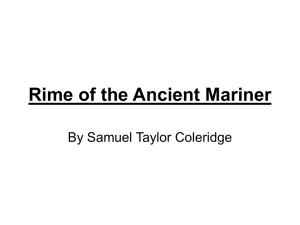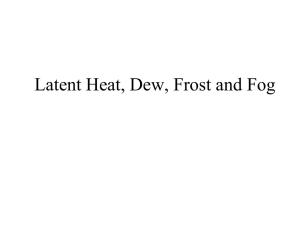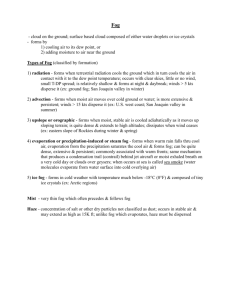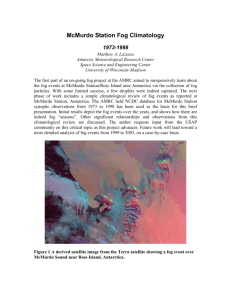the pollutants in fog water and in air at milešovka observatory (czech
advertisement
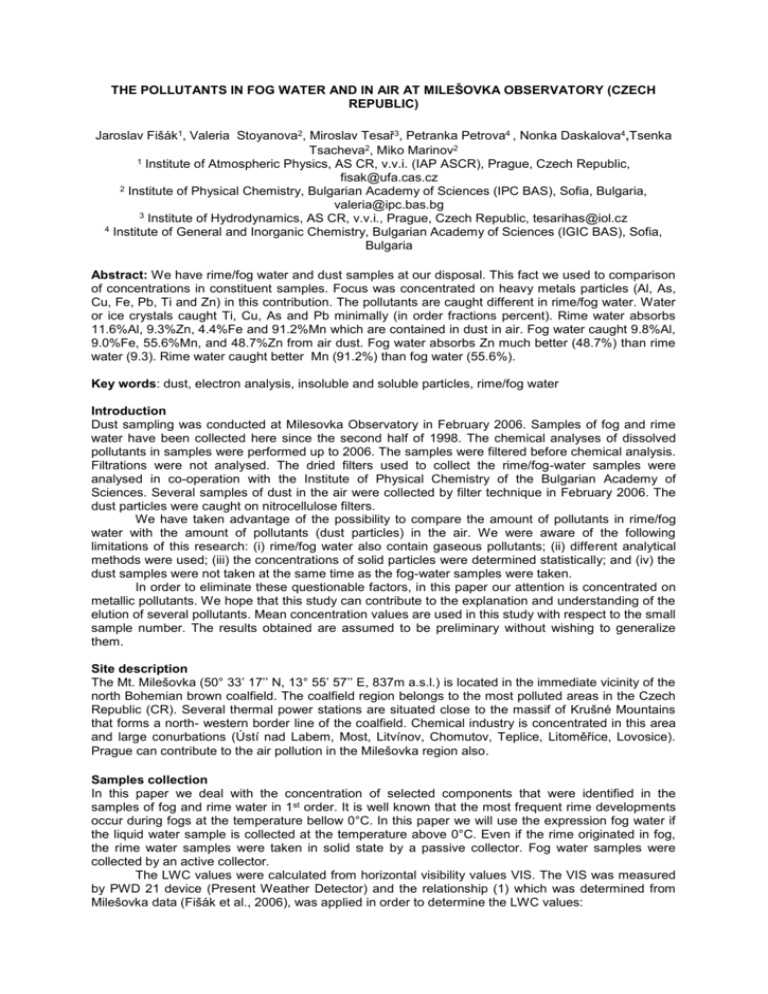
THE POLLUTANTS IN FOG WATER AND IN AIR AT MILEŠOVKA OBSERVATORY (CZECH REPUBLIC) Jaroslav Fišák1, Valeria Stoyanova2, Miroslav Tesař3, Petranka Petrova4 , Nonka Daskalova4,Tsenka Tsacheva2, Miko Marinov2 1 Institute of Atmospheric Physics, AS CR, v.v.i. (IAP ASCR), Prague, Czech Republic, fisak@ufa.cas.cz 2 Institute of Physical Chemistry, Bulgarian Academy of Sciences (IPC BAS), Sofia, Bulgaria, valeria@ipc.bas.bg 3 Institute of Hydrodynamics, AS CR, v.v.i., Prague, Czech Republic, tesarihas@iol.cz 4 Institute of General and Inorganic Chemistry, Bulgarian Academy of Sciences (IGIC BAS), Sofia, Bulgaria Abstract: We have rime/fog water and dust samples at our disposal. This fact we used to comparison of concentrations in constituent samples. Focus was concentrated on heavy metals particles (Al, As, Cu, Fe, Pb, Ti and Zn) in this contribution. The pollutants are caught different in rime/fog water. Water or ice crystals caught Ti, Cu, As and Pb minimally (in order fractions percent). Rime water absorbs 11.6%Al, 9.3%Zn, 4.4%Fe and 91.2%Mn which are contained in dust in air. Fog water caught 9.8%Al, 9.0%Fe, 55.6%Mn, and 48.7%Zn from air dust. Fog water absorbs Zn much better (48.7%) than rime water (9.3). Rime water caught better Mn (91.2%) than fog water (55.6%). Key words: dust, electron analysis, insoluble and soluble particles, rime/fog water Introduction Dust sampling was conducted at Milesovka Observatory in February 2006. Samples of fog and rime water have been collected here since the second half of 1998. The chemical analyses of dissolved pollutants in samples were performed up to 2006. The samples were filtered before chemical analysis. Filtrations were not analysed. The dried filters used to collect the rime/fog-water samples were analysed in co-operation with the Institute of Physical Chemistry of the Bulgarian Academy of Sciences. Several samples of dust in the air were collected by filter technique in February 2006. The dust particles were caught on nitrocellulose filters. We have taken advantage of the possibility to compare the amount of pollutants in rime/fog water with the amount of pollutants (dust particles) in the air. We were aware of the following limitations of this research: (i) rime/fog water also contain gaseous pollutants; (ii) different analytical methods were used; (iii) the concentrations of solid particles were determined statistically; and (iv) the dust samples were not taken at the same time as the fog-water samples were taken. In order to eliminate these questionable factors, in this paper our attention is concentrated on metallic pollutants. We hope that this study can contribute to the explanation and understanding of the elution of several pollutants. Mean concentration values are used in this study with respect to the small sample number. The results obtained are assumed to be preliminary without wishing to generalize them. Site description The Mt. Milešovka (50° 33’ 17’’ N, 13° 55’ 57’’ E, 837m a.s.l.) is located in the immediate vicinity of the north Bohemian brown coalfield. The coalfield region belongs to the most polluted areas in the Czech Republic (CR). Several thermal power stations are situated close to the massif of Krušné Mountains that forms a north- western border line of the coalfield. Chemical industry is concentrated in this area and large conurbations (Ústí nad Labem, Most, Litvínov, Chomutov, Teplice, Litoměřice, Lovosice). Prague can contribute to the air pollution in the Milešovka region also . Samples collection In this paper we deal with the concentration of selected components that were identified in the samples of fog and rime water in 1st order. It is well known that the most frequent rime developments occur during fogs at the temperature bellow 0°C. In this paper we will use the expression fog water if the liquid water sample is collected at the temperature above 0°C. Even if the rime originated in fog, the rime water samples were taken in solid state by a passive collector. Fog water samples were collected by an active collector. The LWC values were calculated from horizontal visibility values VIS. The VIS was measured by PWD 21 device (Present Weather Detector) and the relationship (1) which was determined from Milešovka data (Fišák et al., 2006), was applied in order to determine the LWC values: LWC = 0.0152 VIS-0.8582 (1) where the VIS marked measured horizontal visibility. The LWC values were used to calculation of pollutant concentration in air. The pollutant concentrations in air were calculated from computed mean LWC from relationship (2) PCair [g/m3] = PCsamp [mg/l] x LWC [g/m3] (2) Where: PCair is pollutant concentration in rime/fog water in air PCsamp is pollutant concentration in sample rime/fog water Table 1. Concentration of selected pollutants in rime/fog water and dust in air. rime [ng/m3] Al Mn Fe Zn Ti Cu As Pb fog [ng/m3] dust rime/dust fog/dust soluble insoluble all soluble insoluble all ng/m3 % % 31.08 4.56 15.54 13.62 0.0096 0.0001 0.0044 0.0001 0.0002 0.0000 0.0000 0.0001 31.09 4.56 15.54 13.62 0.0002 0.0000 0.0000 0.0001 25.92 2.78 30.72 71.56 0.2855 0.0008 0.8504 0.0336 0.0135 0.1538 26.21 2.78 31.57 71.59 0.0135 0.1538 0.0000 0.0000 267 5 350 147 9 70 3 22 11.64 91.20 4.44 9.27 0.0021 0.0000 0.0001 0.0004 9.81 55.62 9.02 48.70 0.15 0.22 0.00 0.00 Results The results are in Tab.1. In this table are mean selected pollutants from rime/fog water samples and dust in air contained. The soluble and insoluble pollutant concentrations in rime/fog water are presented separately in Tab. 1. There is presented sum of soluble and insoluble pollutant concentration too. The last two coulombs contained relations rime and fog pollutants concentration to dust pollutant concentrations. Discussions and conclusions Concentrations of soluble forms of elements in rime/fog water are surprisingly high compared to their insoluble forms. Major and minor elements (Al, Mn, Fe, Zn) are presumably present in the atmosphere as secondary phases in the form of (hydro)oxides or carbonates that are dissolved in acid conditions of the liquid phase (pH = 3,9 of rime, and 4,2 of fog, respectively). This tendency is reflected also in relatively high concentrations of the elements in bulk precipitation and throughfall collected at the same sampling site (Fisak et al., 2008), as well in other localities (Skrivan et al., 2000; Vach et al., 2004). Acknowledgements Financial support of projects F1413/2004 from the Bulgarian Science Fund, projects ASCR No. 1QS200420562 and IRP No. AV0Z30420517. Especial thanks for stimulating remarks to P. Skřivan. References Fisak J., Rezacova D. & Mattanen J. 2006. Calculated and measured values of liquid water content in clean and polluted environments. Studia Geophysica et Geodaetica 50: 121-130. Fisak J., Chaloupecky P., Skrivan P. & Spickova J. 2008: The comparison of pollutant concentrations in different types of liquid precipitation. Meteorological Bulletin 61: 79-85. (In Czech) Skrivan P., Navratil T. & Burian M. 2000. Ten years of monitoring the atmospheric inputs at the Černokostelecko region, Central Bohemia. Scientia Agriculturae Bohemica 31: 139-154. CS ISSN 0582-2343 Vach M., Fisak J., Navratil T., Fottova D., Spickova J. & Skrivan P. 2004. The precipitation chemistry over central Bohemia: Attempt to estimate the sources and pathways. Studia Geophysica et Geodaetica 48: 791-809.



